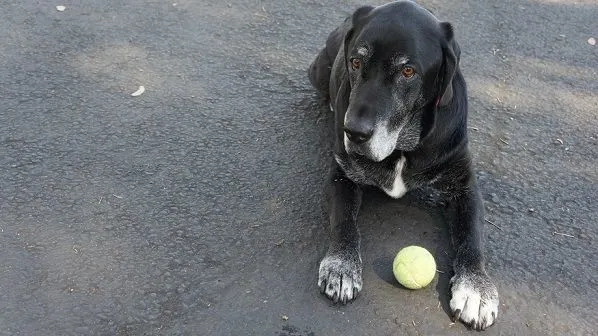Getting a new puppy is a chance to start fresh and take everything I’ve learned about dogs in the last 30 years and apply it.
I’ve given my 10-year-old dog Ace a good life, but there are some areas I’ve learned I could’ve done better.
The following are 6 of my goals for our puppy (he’s now 9 months old!) based on what I know today.
The way I raise my puppy does not have to be the way you would raise yours, but I’m hoping these ideas will inspire you. I’ve ranked these in order of importance with #1 being the most important for me personally.
We won’t all agree with this list, so chime in with your ideas in the comments. Do you think I have it right? Are there others you would add?
How to give your puppy the best life possible

#1. Lots of consistent exercise.
Exercise is my number one top priority with my dogs beyond providing basic needs.
The number one behavioral problem with dogs in the United States is pent-up energy. The number one health problem? Being FAT.
I have done an excellent job exercising my dog Ace over the years. Hell, I even started a dog running business as my full-time job.
It goes without saying that hiking, running and walking with our young dog is my top priority. It’s the easiest way to improve his behavior, keep him socialized and keep him fit.
Training is another area I’ve done really well with Ace. A trained dog gets to experience more and live a more fulfilling life.
I’ve spent thousands of hours working on the basics with Ace, taking him to training classes and challenging him. Because of this, I can take him almost anywhere.
A trained dog is also capable of being left home alone without destroying the house and he can be trusted meeting new people and other dogs.
A trained dog is less likely to end up re-homed or in a shelter.
So, I don’t care what kind of training a person does with his dog. Just do something!
#3. Feeding a dog a raw diet.
I believe a raw dog food diet is the healthiest option for most dogs because we’re talking real, fresh food in its natural form. Dogs are meat eaters!
We can’t control everything, but a healthy diet is one thing we can control.
I introduced Ace to a raw diet when he was about 5 years old. He’s had some trial and error as I learned how to feed homemade raw and whether or not it would work to mix dry dog food (kibble) with raw. Today, he’s back on a high-quality kibble diet because of some health issues.
I’m not comfortable feeding my senior dog a raw diet, however, a raw diet is the way to go for most healthy dogs such as our puppy Remy. You can read my list of pros and cons to a raw food diet here.
#4. Brushing the dog’s teeth.
I don’t brush Ace’s teeth, and I know I don’t provide him with enough things to chew either. So I’ve failed with him in this department.
Thankfully, his teeth don’t seem that bad most likely because of a good diet and the luck of the draw with genetics.
I do plan to start brushing our puppy’s teeth every day in addition to providing him things to chew daily like bully sticks and Nylabones.
See the post: Make brushing your dog’s teeth a habit
#5. Buying pet insurance.
I’ll be getting pet insurance for our puppy.
This year I learned I will spend just about anything possible on my dog, and I don’t want to be in a position again of choosing between a lot of debt vs. not helping my dog.
For good and for bad, the veterinary health care industry is becoming a lot like the human health care industry.
While I’m glad there are treatment options available to pets that were not available in the past, the costs are skyrocketing. I learned this year that specialty veterinary hospitals charge A LOT because they know people have pet insurance now and will pay it. I believe some of these hospitals are taking advantage of pet owners and pet insurance companies. (This will have to be a future post.)
I wish I could fight this system by not buying pet insurance but that is no longer a gamble I’m willing to take with my pets.
I’m looking for accident/illness coverage, not routine care coverage. Any suggestions?
#6. Titer testing instead of over-vaccinating.
My dog Ace has always received the recommended vaccinations for our area, which is a rabies booster every three years and a Parvo/distemper combo every two.
Obviously I want my dog to be protected from these diseases, but the research says most dogs are immune for several years after their initial round of vaccinations as puppies. Some are protected for life! Meanwhile, vaccinations can have negative side effects over time and some dogs can have immediate reactions to them.
So the best alternative is a titer test, which is a blood test that measures the concentration of specific antibodies. Learn more here.
I was not able to afford this option with Ace. Titer tests are more expensive than vaccinations, but I’m going to make this more of a priority with our pup when possible.
See the post: Are too many vaccines bad for adult dogs?
There’s good news!
While this post is focused on puppies, many of the above are things we can all start applying or considering for our dogs no matter what their ages are. It’s easy to sit back and say “should’ve done this” or “should’ve done that.”
Truth is, we can make changes with most things at any point in our dogs’ lives.
What would you add to this list?
Let me know in the comments!
*This post contains affiliate links.



Dena Kellar
Wednesday 23rd of November 2016
I'm disabled so I exercise my Golden Retriever(Sheba) with my Polaris 4 wheeler. She keeps her pace according to the sound of the acceleration of my ATV.
Joni
Tuesday 22nd of November 2016
An idea for teeth brushing....I, like you, sometimes forgot with my last dog; but with my two new dogs I am doing better. What I do is leave the toothbrush & toothpaste "out" in the kitchen where I see it and am reminded. I try to brush every day or two, and use periodontal wipes along the gumlines if I am short on time.
Elaine
Thursday 31st of March 2016
Great article! #4, #5 and #6 are three things I want to do (or do better) with our next dog. The one other thing that comes to mind since Haley's had so much trouble with her knee, is to consider waiting a little longer before spaying or neutering, since there seems to be a connection with hormones and bone growth.
KA
Tuesday 29th of March 2016
Your list looks great - well planned and very comprehensive. Thanks for sharing.
KL
Tuesday 29th of March 2016
I'd rank training and socialization as #1, but that might be partly a function of breed.
A healthy diet and plenty of exercise are definitely in my #2 and 3 spots, probably tied for #2.
I haven't found pet insurance to be terribly helpful (darn pre-existing condition that I'm pretty sure they're just using as an excuse - totally, just like human health care!), but I've heard good things about Embrace, and I liked the company we used until they threw that at us.
I vaccinate religiously but I'm risk averse on the other end of that one. "High standard of veterinary care" is an overall goal we try to stick to with all of our pets, for both routine and emergency situations.
I don't brush my dog's teeth. My groomer does that...
Renchan Li
Wednesday 30th of March 2016
Greatly appreciate your sharing here of the pet insurance experiences.
Lindsay Stordahl
Tuesday 29th of March 2016
Yep, training/socialization/exercise will always be at the top for me. Even before a healthy diet.